
views
Treating the Area
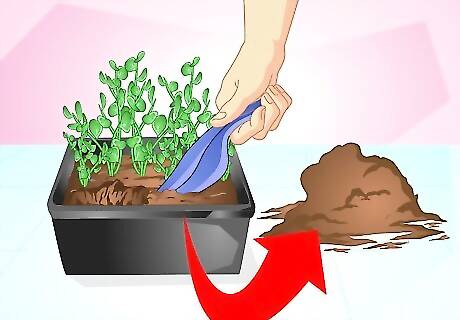
Replace the soil in the pot. This is a key step to ensuring that your cat doesn't repeat his inappropriate behavior. If he can smell urine in the pot, he will be drawn to pee in it again. To completely get rid of the scent, you must take the plant out of the pot and replace the old soil. Choose a soil that is fragrant, as this is likely to be unappealing to your cat. Do not use soil with additives that could be harmful to your cat.
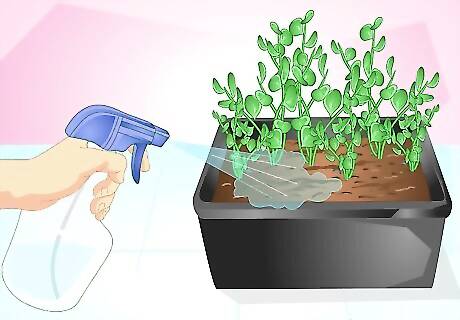
Spritz the soil with cat repellent. Liquid repellants can be found at any pet supply store. These substances are safe to use around animals and will keep your cat out of your plant in the future. All-natural options exist, too, which are a good choice if you are going to be spraying so near to your plant. You can make cat repellent by mixing peppermint, eucalyptus oil, or lemon juice with water (one part juice, three parts water) and spraying the mixture on the dirt around the base of your plant. Keep in mind that what works for one cat might not be effective for another. If your cat doesn't seem to be repelled by peppermint, try lemon (and vice-versa). Essential oils with potent aromas and citrus juices usually work well, however. Remember to spray the plant soil regularly to keep the repellent odor fresh (about once a day), but don't overdo it. A few squirts once a day should do it.

Place rocks or pinecones in the pot. By covering up the soil in the plant pot with a layer of rocks and/or pine cones, you will be removing the main attraction for your cat. If your cat steps in the pot to pee and realizes there is no dirt to paw around, he will probably lose interest quickly. You can substitute pinecones for anything that your cat might find unpleasant to stand on -- just make sure it will not physically hurt your cat if he does jump into the pot. Do not use sand or small pebbles, as these are similar enough to cat litter that it might send your cat the wrong signal.
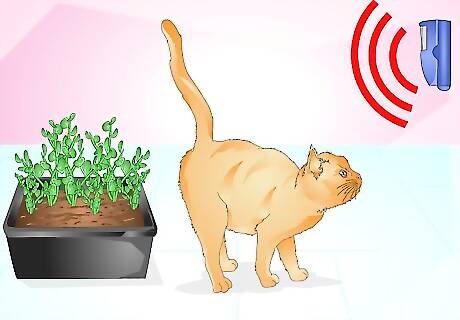
Install a motion-activated noisemaker near the plant. If your cat is startled by an unexpected noise whenever he ventures too near to your plant, he will soon decide to steer clear of the area. Use this tactic as a last resort to keep your cat out of your houseplants, as you don't want to cause unnecessary distress for your pet. Something that both suddenly makes noise and moves when activated is even more likely to deter your cat from coming near it. Check toy and gadget stores near you for items that might work well for this purpose.
Training Your Cat
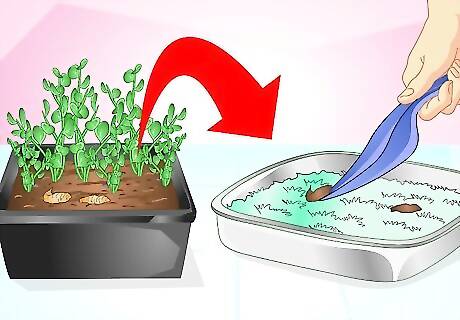
Relocate pet waste from your plant to the litter box. If you find that your cat has urinated or defecated in the soil of your potted plant, remove the waste from the plant and put it in the litter box. This will show the cat that the litter box is the proper place for that. Make sure your cat gets the picture by picking him up and setting him in front of the litter box once you've relocated his waste there. Refrain from "rubbing his nose in it," as this will only make your cat fearful and could increase his confusion about where it is okay to go.
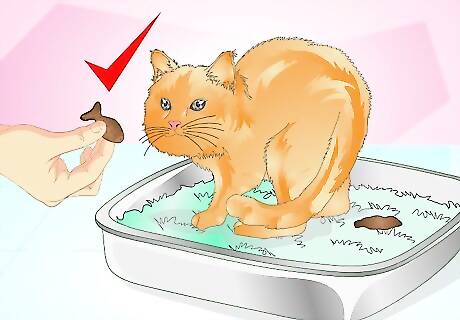
Use positive reinforcement. The best way to train your cat to use the litter box is to reward him when he does so. You can do this by giving your cat a treat, petting him, or playing a game with him using his favorite toy. Regardless of the reward, it is important to do this immediately after your cat uses his box. If your cat is being litter box trained for the first time, be patient with him. Accidents are bound to happen occasionally at first, but if you keep up the positive reinforcement, litter box usage will soon become second nature. Speak softly using an upbeat tone; your cat can interpret your mood on the basis of how you speak to him, so make a happy tone of voice part of your cat's positive reinforcement.
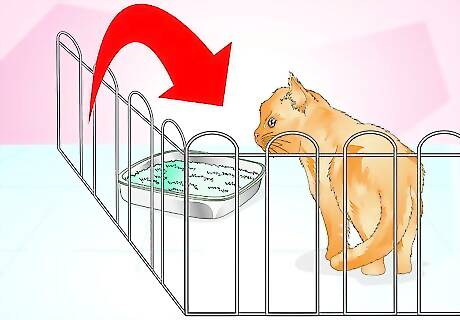
Temporarily confine your cat with his litter box. This is a good strategy for training your cat to use his litter box because he will not be able to venture far from it. This strategy is effective, but less so if you move the litter box after training. If possible, do this in a room where the litter box can be kept indefinitely. Just because your cat isn't allowed to venture outside this area for a day or two doesn't mean you can't visit him! Hang out with your kitty during his temporary confinement to make sure he doesn't get too lonely or distressed. Don't forget to put your cat's food, water, and a few toys in the room with him while he's learning to use the litter box. You shouldn't need to do this for more than a couple of days to get the point across to your cat.
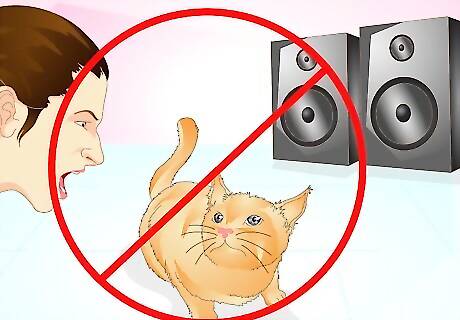
Make your home pleasant for your cat. Cats who feel frequently stressed, anxious, or threatened are more likely to have trouble restricting their restroom activities to the litter box. In order to avoid this situation, do what you can to make your cat comfortable in your home. Not only will this help avoid the problem of houseplant urination, but it will make your pet happier and healthier! Cats are especially sensitive to loud and high-pitched sounds. Avoid unnecessarily noisy activities inside your home unless you can isolate yourself during these events or your cat has a place to hide if he wants to. Do not intentionally startle or frighten your cat. If you have frequent visitors to your home, inform them that you have a cat and that they should act calmly and speak softly when they are around him.
Making the Litter Box Appealing

Place a litter box inside your home. Even if your cat is typically let outside to do his business, you should have at least one litter box in your house so he has the option to use it when he is indoors. If you do not already have a litter box for your cat, this could be the reason he peed in your plant in the first place. Make sure your cat can easily access his litter box; don't put it in a room with a door that could accidentally close or in a location in your house that is difficult to get to. You should have at least one litter box per cat, in case one of your cats is picky about using boxes that other cats have already used.
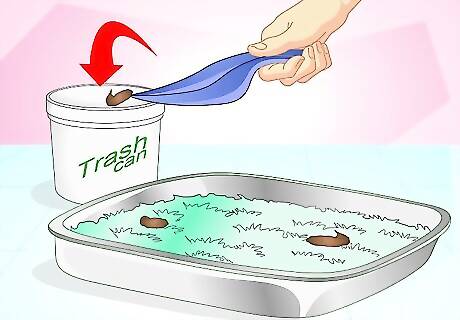
Keep the litter box clean. Many cats won't use a litter box that is too dirty. This is especially true if you have multiple cats, as too much waste matter from one cat might repel the other(s). In order to make sure your cat will use his box when he needs to go, scoop it out at least once a day. Give it a more thorough cleaning once per week. Do not store your pet's waste in a receptacle located right next to the litter box. Doing so could fail to sufficiently remove odors from the litter box area, which could make your cat not want to use his box even if it has been recently scooped. For your 'thorough' weekly cleaning, use an unscented soap or baking soda so you don't inadvertently repel your cat with an scent he doesn't like.
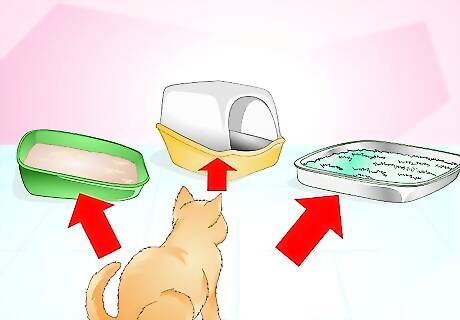
Find out what's comfortable for your cat. Experiment with different litter box configurations to see if there's something about the box itself that caused your cat to use your plant to relieve himself instead. Possible factors include the presence of a liner, a lid on the box, a swinging door, or the size or location of the box itself. Start with the easy fixes first, like removing the litter box liner. If that doesn't work, try the next simplest modification. Give your cat a couple of days after each change to see if he seems to approve. As a last resort, replace the box with a bigger one and switch to a different litter type or brand.
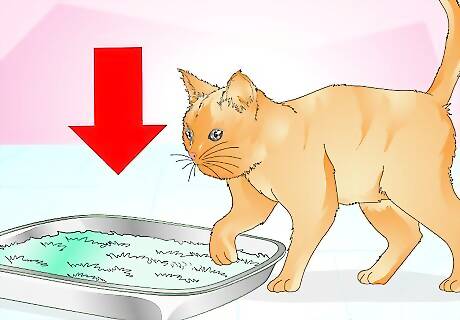
Keep litter boxes on the floor. You should make it as easy as possible for your cat to use its designated restroom, which means keeping the box on his level. Imagine if you had to climb or jump up to a platform positioned above your head every time you needed to use the toilet! This would be rather inconvenient and unpleasant, and your cat wouldn't like it, either. This is especially important if your cat is elderly or very young. The last thing you want to do is have your cat injure itself while trying to get to his litter box! This would also create a negative association for the cat that could make him averse to using the box in the future. If you lack sufficient floor space for a litter box and absolutely must put it up off the ground, build or purchase a small set of pet stairs to make it easy for your cat to get to his box.



















Comments
0 comment